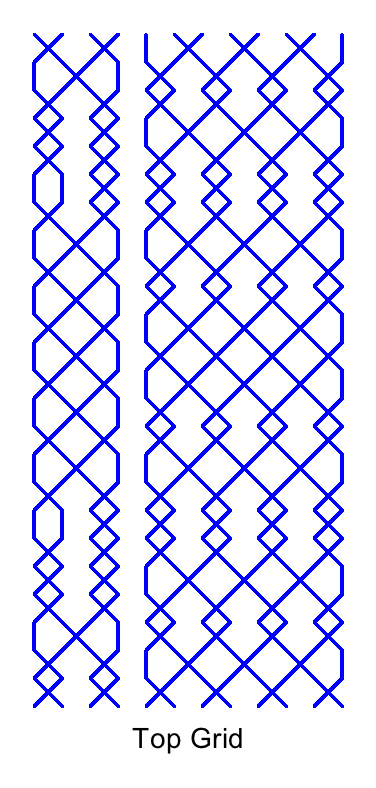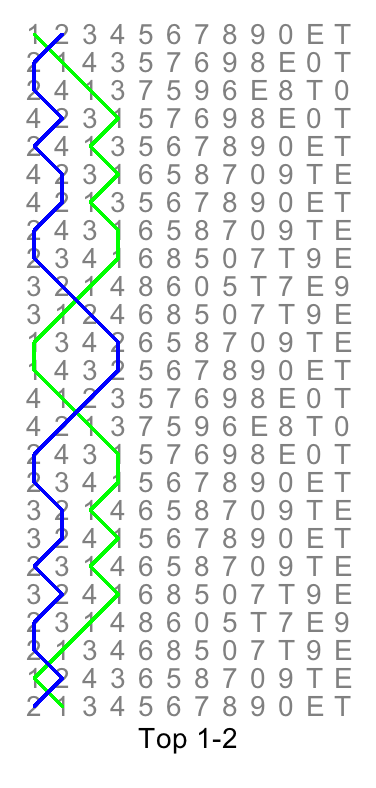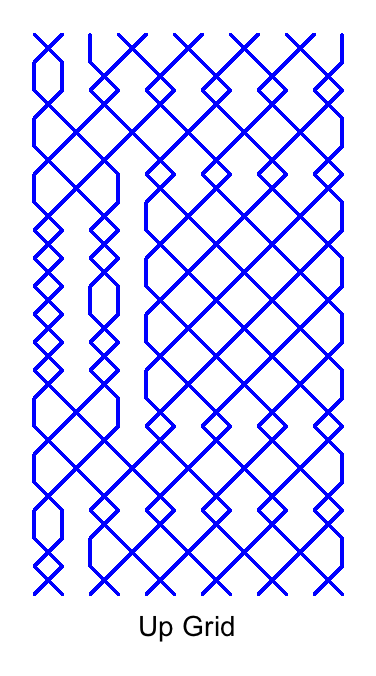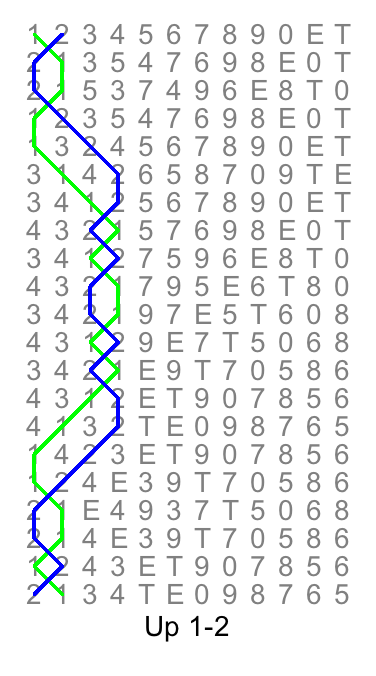A couple of weeks ago I rang David Pipe's "particles" peal of spliced maximus, on tower bells at Tulloch. It's a cyclic 12-part consisting of methods designed to generate lots of music based on forward and backward runs of consecutive bells. Most of the methods are best learned from the grid rather than by blue lines, so it's an exercise in structural ringing.

I found out that the band at St Wilfrid's, York, have been ringing two of the simpler methods, Top and Up, in a short touch of spliced: Top, Up, Top, Up giving 88 rows. The proverbial astute reader will realise that St Wilfrid's is a 10-bell tower, but that's not a problem because both methods are based on fairly simple rules that work on any number of bells from 8 upwards. Also, the methods are ideal for handbells because each pair works closely together. Next Saturday is the Scottish Handbell Day, so I have decided that one of the sessions will focus on spliced Top and Up. The aim is to work up from 8 to 12, giving a relatively easy (I hope) way into 12-bell ringing for the less experienced ringers because each pair never gets very far apart, and also giving a relatively easy (again, I hope) introduction to wrong hunting and point blows.
First let's look at Top. The grid is shown on the right.
The rule for the back bell pairs (5-6 upwards) is as follows.
- Reverse hunt two changes to a backstroke point.
- Forward hunt two changes to a roll-up in the home position.
- Dodge with yourself.
- Forward hunt three changes to a handstroke point.
- Reverse hunt three changes to a roll-up in the home position.
- Do it all again.
The hunting takes place within the back 8 places, so 5th and 12th places are made when necessary.



The front bell pairs are more complicated. One possibility is to learn the pattern for each pair. Alternatively, think of the following sequence.
- Plain hunt for two changes.
- Dodge.
- Make 1st and 2nd place, dodge in 3-4.
- Plain hunt for a complete cycle of eight changes.
- Plain hunt for two more changes.
- Make 1st and 2nd place, dodge in 3-4.
- Dodge.
- Plain hunt for two changes.
- Dodge at the lead end.
After a lead of Top, 1-2 are swapped and all the other bells are back where they started.
The diagrams show the lines for 1-2, 3-4, and 7-8 as a representative back bell pair.

Now for Up. The grid is shown on the right.
The rule for the back bells (5-6 upwards) is as follows.
- Reverse hunt two changes to a backstroke point.
- Forward hunt three changes to a handstroke point just after returning to your home position for a backstroke roll-up.
- Reverse hunt until reaching a backstroke point on a reverse roll-up.
- Forward hunt three changes to a handstroke point.
- Reverse hunt until reaching the lead end on a reverse roll-up.
The hunting takes place within the back 8 places, except that the first and last points in the lead go down as far as 3rd place.
The instruction "reverse hunt until reaching a backstroke point on a reverse roll-up" is important. It avoids the need to learn or work out how much reverse hunting to do. Similarly "reverse hunt until reaching the lead end on a reverse roll-up". In the particles peal, significant landmarks often occur at roll-ups, which is a big help once you embrace the style of ringing.




The rule for the front bells is simpler than in Top.
- 1-2 make a place around each other, then hunt up to 4th place and do treble bob around each other, then reverse the work from the centre of the treble bob, finally dodging at the lead end.
- 3-4 start by reverse hunting to a backstroke point in 4th and 6th places, then forward hunt to come together on the front for a triple dodge, then reverse the work, finally crossing in 3-4.
After a lead of Up, 1-2 are swapped, 3-4 are back where they started, and all the other bells are in reverse order.
The diagrams show the lines for 1-2, 3-4, 5-6 and 7-8.
The whole touch is in CompLib here, and here is the calling with the lead ends:
88 Spliced Maximus (2m)
1234567890ET
-----------------
Top 2134567890ET
Up 1234TE098765
Top 2134TE098765
Up 1234567890ET
-----------------
The back-bell roll-ups reverse each time Up is rung, so the instructions about ringing until a roll-up is reached have to be interpreted appropriately. I expect we will get used to it.
Comments
Amazing
Adjustment for major and royal